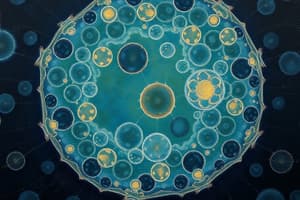Podcast
Questions and Answers
Who is considered the father of cytology?
Who is considered the father of cytology?
- Anton Wan Leeuwenhoek
- Robert Hooke (correct)
- Theodore Schwann
- Matthias Schleiden
What is the difference between prokaryotic and eukaryotic cells?
What is the difference between prokaryotic and eukaryotic cells?
- Prokaryotic cells are larger than eukaryotic cells
- Eukaryotic cells have a cell wall while prokaryotic cells do not
- Eukaryotic cells are unicellular while prokaryotic cells are multicellular
- Prokaryotic cells have a nucleus while eukaryotic cells do not (correct)
What is the fluid mosaic model?
What is the fluid mosaic model?
- A model of protein synthesis in cells
- A model of the structure of cell membranes (correct)
- A model of the movement of molecules in cells
- A model of the function of organelles in cells
Study Notes
Introduction to Cells and their Structures
- Robert Hooke discovered the first cell in 1665 by observing a cork under his microscope.
- The study of cells is known as cytology, and Hooke is considered the father of cytology.
- Anton Wan Leeuwenhoek discovered the first living cells in 1674, including bacteria, amoebas, erythrocytes, and spermatozoa.
- Matthias Schleiden and Theodore Schwann gave the cell theory in 1838-1839, stating that every organism is made up of cells, and cells are the basic functional and structural unit of life.
- Rudolf Virchow added the statement "Omnis Cellula e Cellula" in 1855, meaning every cell arises from pre-existing cells, completing the modern cell theory.
- Protists are unicellular eukaryotes, and examples include amoeba, chlamydomonas, and yeast.
- There are two types of cells: prokaryotic and eukaryotic, with differences in size, nucleus, organelles, and protein synthesis.
- Cells vary in size, shape, and activities, with examples including leukocytes, erythrocytes, and inclusion bodies.
- Bacteria are prokaryotes with surface structures such as pili, fimbrae, and flagella, and can be classified into gram-positive and gram-negative.
- Eukaryotic cells have a cell wall and cell membrane, with differences in composition and function depending on the organism.
- The fluid mosaic model, given by Singer and Nicolson in 1972, describes the structure of cell membranes as a lipid bilayer with different types of proteins and oligosaccharides.
- Transport in cells can be passive or active, depending on the movement of molecules along their concentration gradients.
Studying That Suits You
Use AI to generate personalized quizzes and flashcards to suit your learning preferences.
Description
Take this quiz to test your knowledge on the fascinating world of cells and their structures. From the history of cell discovery to the modern cell theory, you will learn about the different types of cells, their sizes, shapes, and activities. Test your understanding of the cell membrane, the fluid mosaic model, and transport in cells. Challenge yourself with questions on prokaryotic and eukaryotic cells, bacteria, and protists. This quiz is perfect for anyone interested in biology or curious about the




